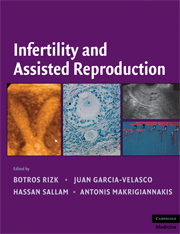Book contents
- Frontmatter
- Contents
- Contributors
- Foreword
- Preface
- Introduction
- PART I PHYSIOLOGY OF REPRODUCTION
- 1 Folliculogenesis: From Preantral Follicles to Corpus Luteum Regression
- 2 Mechanisms of Follicular Development: The Role of Gonadotrophins
- 3 Human Follicle Culture In Vitro
- 4 Endometrial Receptivity
- 5 Molecular Mechanisms of Implantation
- PART II INFERTILITY EVALUATION AND TREATMENT
- PART III ASSISTED REPRODUCTION
- PART IV ETHICAL DILEMMAS IN FERTILITY AND ASSISTED REPRODUCTION
- Index
- Plate section
- References
4 - Endometrial Receptivity
from PART I - PHYSIOLOGY OF REPRODUCTION
Published online by Cambridge University Press: 04 August 2010
- Frontmatter
- Contents
- Contributors
- Foreword
- Preface
- Introduction
- PART I PHYSIOLOGY OF REPRODUCTION
- 1 Folliculogenesis: From Preantral Follicles to Corpus Luteum Regression
- 2 Mechanisms of Follicular Development: The Role of Gonadotrophins
- 3 Human Follicle Culture In Vitro
- 4 Endometrial Receptivity
- 5 Molecular Mechanisms of Implantation
- PART II INFERTILITY EVALUATION AND TREATMENT
- PART III ASSISTED REPRODUCTION
- PART IV ETHICAL DILEMMAS IN FERTILITY AND ASSISTED REPRODUCTION
- Index
- Plate section
- References
Summary
INTRODUCTION
Twenty-five years into the history of in vitro fertilization (IVF), endometrial receptivity remains both puzzling and challenging. The challenge comes from the fact that embryo implantation rates, however markedly improved in the later years, remain the bottleneck of assisted reproduction treatments (ART). In contrast to all the steps that take place earlier in the chain of ART measures such as notably multiple follicular stimulation, oocyte retrieval, fertilization, and cleavage rates, which have an efficacy largely more than 50 percent, embryo implantation rates continue to lag behind.
The puzzling fact about endometrial receptivity is that the simplest way of priming it is with the sole use of exogenous E2 and progesterone, as it was conceived for women whose ovaries have prematurely failed over twenty years ago. Indeed, implantations rates achieved in hormonal regimens developed for recipients of donor egg IVF remain remarkable even by today's standards, being at best equaled but to this date never surpassed, either in natural cycles or in any type of ART.
The lasting lesson that donor egg IVF has been teaching us is that E2 and progesterone suffice for triggering an optimal endometrial receptivity. This implies that other factors produced by the ovary such as notably androgens are at best unnecessary but often capable of harming. In controlled ovarian hyperstimulation (COH), as performed in ART, the ovaries are stimulated with supraphysiological levels of gonadotropins.
Keywords
- Type
- Chapter
- Information
- Infertility and Assisted Reproduction , pp. 38 - 45Publisher: Cambridge University PressPrint publication year: 2008
References
- 1
- Cited by



